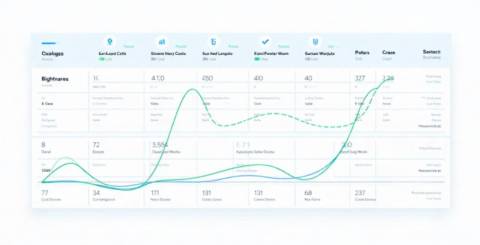Cost, Timeline & Tech Stack: What It Takes to Build Lending Software in 2025

Building lending software isn’t just a technical project—it’s a business decision. Whether you're a fintech founder or part of a traditional lending institution trying to go digital, three questions will shape everything that follows: What’s this going to cost? How long is it going to take? And what stack will support what we’re trying to build?
There’s no one-size-fits-all answer. But there is a way to break it down clearly.
This article will explain the real costs, realistic timelines, and recommended tech stack behind modern lending platforms. If you're planning to partner with a lending software development company, this will help you come to that conversation informed and prepared to build something that works long-term.
1. What Determines the Cost of Lending Software?
The cost of building lending software depends on the features you need, the complexity of your workflows, and whether you’re building an MVP or a full-fledged platform.
Basic Cost Ranges:
Project Type
Estimated Cost (USD)
MVP Lending Platform
$30,000 – $60,000
Mid-Sized Platform
$60,000 – $120,000
Enterprise-Level Solution
$150,000 – $300,000+
What Impacts Cost:
Features: KYC/AML compliance, loan calculators, credit scoring, dashboards, notifications.
Integrations: Banking APIs, payment gateways, credit bureaus, third-party services.
User Roles: Admins, borrowers, underwriters, agents—all require separate flows.
Security & Compliance: PCI DSS, GDPR, SOC2—essential but adds development time.
Customization: Off-the-shelf components cost less but offer limited flexibility.
Hiring a trusted lending software development company ensures you only pay for what matters—and don’t overspend on unnecessary bloat.
2. How Long Does It Take to Build a Lending Platform?
Time is money, especially in fintech. While every build is different, here’s a rough idea of how timelines play out:
General Timelines:
Development Scope
Timeframe
Prototype / PoC
4–6 weeks
MVP Version
10–14 weeks
Full Platform (Go-to-Market)
4–6 months
Enterprise Solution
6–9+ months
Time Factors:
Requirement clarity: Vague specs always slow things down.
Feedback cycles: Faster approvals = faster delivery.
Team size: A senior team with fintech experience cuts timeline significantly.
Third-party delays: Bank API approvals or external vendors can bottleneck progress.
Speed matters—but not at the cost of stability. The best approach is phased development with regular releases and testing.
3. Recommended Tech Stack for Lending Software
Choosing the right tech stack impacts everything from performance and security to maintenance cost and scalability.
Here’s what most top-tier lending software development companies use in 2025:
Frontend:
React.js or Angular – For fast, responsive user interfaces.
Tailwind CSS – Clean design with minimal effort.
Backend:
Node.js / Express.js – Highly scalable and real-time ready.
Laravel (PHP) – Great for rapid development and built-in security.
Java (Spring Boot) – For large-scale, bank-grade solutions.
Database:
PostgreSQL – For structured, relational data.
MongoDB – For handling semi-structured application data.
Redis – For caching and real-time transaction updates.
Cloud & DevOps:
AWS / Azure / GCP – Hosting, auto-scaling, storage.
Docker + Kubernetes – Containerization and deployment.
CI/CD Pipelines (GitHub Actions, Jenkins) – Faster releases with quality checks.
Compliance & Security Tools:
Onfido / Alloy – KYC/AML integration.
Plaid / Yodlee – Bank data aggregation.
Snyk / OWASP ZAP – Application security testing.
A good lending software development company tailors the stack to your goals—never the other way around.
4. Key Features to Include in 2025
No two lending platforms are identical, but here are the core modules you’ll want to consider:
Borrower Side:
Loan application wizard
Eligibility checker
KYC & document upload
Real-time loan status tracking
Notifications & reminders
Lender/Admin Side:
Loan origination dashboard
Automated underwriting engine
Risk scoring & analytics
Payment tracking & disbursement
Repayment schedules and collections tools
Extra Features (Optional but Impactful):
Multi-language support
Role-based access control
Credit bureau integrations (Equifax, Experian)
Embedded chat or support
Mobile app (iOS/Android)
5. What About Software Maintenance Cost?
Too many startups underestimate software maintenance cost, and it catches up fast. Whether it’s bug fixes, security patches, or upgrading third-party libraries—maintenance is not optional.
Ongoing Maintenance May Include:
Regular security audits and patches
API updates and third-party SDK changes
Hosting & cloud infrastructure costs
User support and new feature rollouts
On average, annual maintenance costs can be 15–25% of your total development cost. The right lending software development company should offer post-launch support to keep your platform stable and compliant.
Final Thoughts
Building lending software in 2025 is no small task ,but it’s more accessible and scalable than ever before. If you have clarity on your product, a realistic understanding of the costs and timeline, and a trusted lending software development company to guide the way, you're set up for success.
Invest in the right technology, phase your launch intelligently, and don’t skip on compliance or long-term support. Your lending platform should do more than work—it should grow with you.
Frequently Asked Questions
Q1. How much does it cost to build lending software in 2025?
Costs typically range between $30,000 to $150,000+ depending on the features, complexity, and level of customization.
Q2. How long does it take to build a custom lending platform?
MVPs may take 10–14 weeks, while full-scale platforms often require 4–6 months or more.
Q3. What tech stack is best for lending software development?
A modern stack includes React/Angular (frontend), Node.js or Laravel (backend), PostgreSQL or MongoDB (database), and cloud services like AWS or Azure.
Q4. What is the software maintenance cost after launch?
You should budget around 15–25% of your initial development cost annually for ongoing support, updates, and infrastructure.
Q5. How do I choose the right lending software development company?
Look for fintech experience, proven case studies, strong security/compliance knowledge, and the ability to offer long-term technical support.
Similar Articles
Modern businesses are drowning in communication overload, and much of that burden stems from outdated tools that simply can’t keep up
Learn why robust security is crucial for super app development. Explore key strategies and best practices for mobile app development security.
Walkie-talkies with an extensive reception capacity have changed significantly when it comes to portable communication by displaying cutting-edge features with seamless connectivity that covers more than just the state
USB-C technology has revolutionized the way we charge our devices, offering faster charging speeds, higher power delivery, and universal compatibility across multiple devices
Discover expert mobile app development strategies to create a viral app that attracts users and boosts engagement
Optimize app localization for iOS users across the EU with language, cultural, and regulatory adaptations. Engage users and boost retention with these tips!
Discover the top 10 mobile app development trends of 2024! Explore 5G, AI, AR/VR, blockchain, and more to stay ahead in the ever-evolving app development landscape.
With its triple-lens design and fantastic photo and video quality, the iPhone 11 Pro Max is extensively acknowledged for its superior camera system. But problems can occur with also one of the most advanced technologies. If you're having issues with the iPhone 11 pro max camera lens, knowing the typical problems and how to repair them
Protect your app from threats with AppSealing's robust, all-inclusive security solution. Safeguard user data, ensure compliance, and maintain top performance.









